Should I Be Trimming My Dog’s Nails?
For many dog owners, nail trimming is one of those tasks that they prefer to avoid at all costs.
For many dog owners, nail trimming is one of those tasks that they prefer to avoid at all costs. Not only is it fiddly and stressful, but there is also a real risk of cutting the nails too short and causing pain to your four-legged friend. This leads many owners to question whether trimming their dogs' nails is even necessary. In this blog, our founder, Dr Scot Plummer, shares his thoughts.
“In the past 5 or so years, I have stopped trimming dog’s nails and also talked most clients out of doing so. It’s my belief that this is one of the greatest causes of fear when taking your dog to the vet.
Even if your dog’s nails are only trimmed too short once, the memory of the pain can stay with them forever. Every time they visit the place where the incident occurred, they can immediately grow fearful or anxious that they’re there to have their nails cut again. If the incident occurred at a veterinary clinic, they will often spend the whole appointment worried that pain is about to occur – regardless of the reason for the visit. This worry can last for several hours after the visit is over, which is not at all pleasant for your dog.
In a similar situation, Scot was once trying to vaccinate a small breed terrier that was extremely terrified – biting and screaming – prior to him having any contact at all with it. He decided to hold onto the terrier to try calming it down. The dog was muzzled so that Scot could perform the vaccination, along with a very limited exam with the goal of avoiding pain or fear. He saw the terrier again 12 months later for its next set of vaccinations. The dog was again muzzled but didn’t get upset as quickly and tolerated the exam better. At the terrier’s next visit 12 months later, it was quite friendly – muzzling was not required, and the dog did not become upset at all.
Scot asked the owner if the dog had ever had its nails trimmed, to which she replied yes. He explained that the change in the terrier’s attitude was because it hadn’t had this fear/pain experience with him at any of his three visits, so the dog was satisfied that Scot wasn’t going to cause it pain.
While we have never seen long nails cause a dog any particular issues, we have occasionally seen nails that grow in a circle back into the pad (which can cause some discomfort and make it difficult for the dog to walk). This is the only instance where we would actually need to trim their nails.
Many owners prefer to trim their dogs' nails because they can be noisy on tiled and timber floors, and they can become more easily caught in clothing. Neither of these are legitimate reasons, however.
Trimming with a cutting device utilises a combination of cutting and pressure to get through the thick nail. This pressure can often be felt many millimetres away from where the actual cutting is occurring – just because there isn’t any bleeding doesn’t mean that your dog isn’t experiencing pain or discomfort.
If you must trim your dog’s nails, we recommend being extremely conservative or even using a nail file. This will take longer, but results in a more rounded end to the nail – which is actually softer on skin and clothing (unlike cutting, which results in an even sharper edge).
Although it is possible to safely trim your dog’s nails, this is something that we do not offer and do not recommend at Melbourne Pet Surgery (except for in situations when the nails are growing in a circle). Regular walks outside and on concrete will naturally wear the nails down, keeping them at a manageable length and ensuring that your dog doesn’t become fearful or anxious of the vet.
